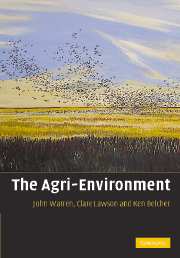Book contents
- Frontmatter
- Contents
- Preface and Acknowledgements
- 1 An introduction to agro-ecology
- 2 Agricultural support and environmentalism
- 3 Environmental impacts of agriculture
- 4 Principles behind agri-environment schemes
- 5 Farm conservation planning
- 6 Habitat management
- 7 The management of agricultural wastes
- 8 Low-impact farming systems
- 9 Landscape and farmscape ecology
- 10 The future of agri-environmental systems
- Glossary
- References
- Index
8 - Low-impact farming systems
Published online by Cambridge University Press: 08 December 2009
- Frontmatter
- Contents
- Preface and Acknowledgements
- 1 An introduction to agro-ecology
- 2 Agricultural support and environmentalism
- 3 Environmental impacts of agriculture
- 4 Principles behind agri-environment schemes
- 5 Farm conservation planning
- 6 Habitat management
- 7 The management of agricultural wastes
- 8 Low-impact farming systems
- 9 Landscape and farmscape ecology
- 10 The future of agri-environmental systems
- Glossary
- References
- Index
Summary
Introduction
This chapter is entitled ‘low-impact farming systems’ by which we mean agricultural systems designed (at least in part) to have less dramatic impacts on the environment than does conventional agriculture. There are however a number of problems with defining low-impact farming systems in this way. Firstly, what are environmental impacts, how do you measure them and indeed can environmental change be simply measured on a scale of good through to bad? Secondly, our definition is a comparative one, measured against conventional agriculture, but this begs the obvious question – what is conventional agriculture? Thirdly, what is a system, how tightly restricted are the various methods of farming? In this chapter we examine these issues in some detail, because unless we can rigorously define what a low-impact farming system is, then how can we design one or measure what its environmental impacts are? This chapter reviews the aims and methods of some of the more common farming systems that claim to have environmental benefits or to be less environmentally harmful, including organic agriculture and agri-environment schemes. The theory and practice of sustainable agricultural production is discussed along with the considerable technical difficulties involved in comparing the environmental impacts of different production systems. The assessment of relative environmental impacts of different farming systems is not only difficult; it is central to being able to design low-impact farming systems, because how do you know if your aims are being achieved unless you can quantify them?
- Type
- Chapter
- Information
- The Agri-Environment , pp. 143 - 161Publisher: Cambridge University PressPrint publication year: 2007



